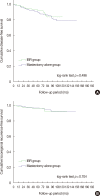Oncologic Safety of Immediate Breast Reconstruction for Invasive Breast Cancer Patients: A Matched Case Control Study
- PMID: 27064557
- PMCID: PMC4822109
- DOI: 10.4048/jbc.2016.19.1.68
Oncologic Safety of Immediate Breast Reconstruction for Invasive Breast Cancer Patients: A Matched Case Control Study
Abstract
Purpose: The purpose of this study was to compare locoregional recurrence-free survival (LRFS) and disease-free survival (DFS) between patients undergoing mastectomy and immediate breast reconstruction (IBR) and those undergoing mastectomy alone.
Methods: A retrospective review of patients who underwent mastectomy and immediate breast reconstruction for resectable invasive breast cancer between 2002 and 2010 at a single center was conducted. These cases were matched to patients who underwent mastectomy alone in the same time period, performed by 1:2 matching. Matching control variables included age, tumor size, axillary lymph node metastasis, and estrogen receptor status. Overall, 189 patients were identified in the IBR group, and 362 patients were matched to this group.
Results: In the IBR group, 75 patients (39.7%) underwent conventional total mastectomy, 78 (41.3%) underwent skin-sparing mastectomy (SSM), and 36 (19.0%) underwent nipple-sparing mastectomy (NSM). The IBR group was significantly younger than the control group (41.9 and 45.1 years, respectively) (p=0.032), in spite of matching between three age groups. The DFS rates were similar between the IBR group and mastectomy alone group, at 92.0% and 89.9%, respectively, at 5-year follow-up (log-rank test, p=0.496). The 5-year LRFS was 96.2% in the IBR group and 96.4% in the mastectomy alone group (log-rank test, p=0.704), similar to data from previous reports. Subgroup analyses for SSM or NSM patients showed no differences in LRFS and DFS between the two groups. Additionally, in stage III patients, IBR did not cause an increase in recurrence.
Conclusion: IBR after mastectomy, including both SSM and NSM, had no negative impact on recurrence or patient survival, even in patients with advanced disease.
Keywords: Locoregional neoplasm recurrence; Mammaplasty; Mastectomy; Matched case-control study.
Conflict of interest statement
Figures



References
-
- Drucker-Zertuche M, Robles-Vidal C. A 7 year experience with immediate breast reconstruction after skin sparing mastectomy for cancer. Eur J Surg Oncol. 2007;33:140–146. - PubMed
-
- van Mierlo DR, Lopez Penha TR, Schipper RJ, Martens MH, Serroyen J, Lobbes MB, et al. No increase of local recurrence rate in breast cancer patients treated with skin-sparing mastectomy followed by immediate breast reconstruction. Breast. 2013;22:1166–1170. - PubMed
-
- Romics L, Jr, Chew BK, Weiler-Mithoff E, Doughty JC, Brown IM, Stallard S, et al. Ten-year follow-up of skin-sparing mastectomy followed by immediate breast reconstruction. Br J Surg. 2012;99:799–806. - PubMed
LinkOut - more resources
Full Text Sources
Other Literature Sources

